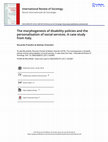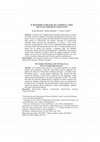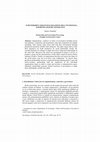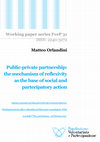Papers by Matteo Orlandini
Nella seconda parte della ricerca empirica della Fondazione Alma Mater del gruppo di lavoro “Welf... more Nella seconda parte della ricerca empirica della Fondazione Alma Mater del gruppo di lavoro “Welfare Aziendale – Area conciliazione famiglia-lavoro, sostegno ai generi e formazione” si è cercato di capire quale sia il contenuto dello scambio sociale che avviene tra lavoratore ed impresa: che cosa mettono sul piatto le aziende in termini di welfare aziendale? Quali benefici, servizi, forme di organizzazione flessibile? Cosa contrattano le rappresentanze sindacali? Che concessioni fanno per ottenere il welfare aziendale?
SOCIOLOGIA E POLITICHE SOCIALI, 2010
ABSTRACT Orizzonte di lettura sulle pubblicazioni: Borzaga C. e Fazzi L. (a cura di), Governo e o... more ABSTRACT Orizzonte di lettura sulle pubblicazioni: Borzaga C. e Fazzi L. (a cura di), Governo e organizzazione per l’impresa sociale, Carocci editore, Roma, 2008. Colozzi I e Prandini R. (a cura di), I leader del Terzo settore. Percorsi biografici, culture e stili di leadership, FrancoAngeli, Milano, 2008. Dym B. e Hutson H., Alla guida di un’impresa sociale. La leadership nel Terzo settore, Erickson, Trento, 2008. Hansefeld Y. (eds.), Human Services as Complex Organizations, Sage, Los Angeles, 2009
SOCIOLOGIA E POLITICHE SOCIALI, 2014
The paper presents an old but dismissed concept: co-production of public services. The basic defi... more The paper presents an old but dismissed concept: co-production of public services. The basic definition is very simple: people who use services contribute to the production of services. The application is more complex: a mutual subsidiary relationship between users, staff and communities. The paper offers an overview of the literature on co-production, through the presentation of three semantics: the overlap of regular and consumer producer (Ostrom and colleagues), the user involvement for service quality (Pestoff and colleagues), the core approach to implementing personalisation (Needham and colleagues). After showing some Italian example, the paper proposes integration between the couple personalisation-coproduction for a new service design.
International Review of Sociology, 2018

INTERNATIONAL REVIEW OF SOCIOLOGY, 2018
Across Europe, and particularly since the 2008 Financial Crisis, new
demands for tailor-made serv... more Across Europe, and particularly since the 2008 Financial Crisis, new
demands for tailor-made services came from different actors and
perspectives: user-led organizations, intellectuals, policy makers,
social workers, advocacy organizations, which call for a new way
of programming, realizing and evaluating social policies.
Personalization became a relevant part of the so called ‘welfare
innovation narrative’, which concerns – to name but a few –
English personalization agenda, Scottish self-directed support,
Finnish education system, Norwegian cash-for-care policies. Even
the European Commission is addressing new social services,
reshaped through users’ capabilities. The aim of this paper is to
critically explain, through a case study focused on the Sardinian
disability policy, how social policy’s morphogenetic cycles
influence the governance of personalized disability plans and,
consequently, the possibility of their implementation.
Welfare aziendale e benessere della persona. Primo Rapporto sulla politica nazionale Family Audit, 2018
Ad immagine delle più famose certificazioni nazionali ed internazionali di qualità del prodotto, ... more Ad immagine delle più famose certificazioni nazionali ed internazionali di qualità del prodotto, di qualità ambientale o di certificazione etica, dalla fine degli anni '90 in diversi paesi europei è stata introdotta la certificazione aziendale di qualità familiare. È uno strumento che attesta, su base volontaria, se e quanto i processi di lavoro interni ad un'organizzazione siano "a misura" di famiglia. In questo capitolo si analizzano i piani di attività delle imprese con certificazione Family Audit.
Welfare aziendale e benessere della persona. Primo Rapporto sulla politica nazionale Family Audit, 2018
Molto spesso i fautori della conciliazione lavoro-famiglia sostengono che l'azienda che implement... more Molto spesso i fautori della conciliazione lavoro-famiglia sostengono che l'azienda che implementa queste misure abbia un beneficio interno, oltre a garantire un migliore benessere per il dipendente e la sua famiglia. In questo capitolo, ci soffermiamo su questo primo assioma: le politiche aziendali family-friendly producono un ritorno interno all'impresa che le promuove.

Sociologia e Politiche Sociali, vol. 20, 3/2017, 2017
I working carers rappresentano una sfida urgente sia per i sistemi di welfare che per le imprese.... more I working carers rappresentano una sfida urgente sia per i sistemi di welfare che per le imprese. Servendosi dell'approccio teorico del work-family interface, il paper analizza gli effetti prodotti sul benessere familiare dalle misure di FamilyAudit, una politica nazionale di certificazione aziendale degli interventi di conciliazione. La ricerca è stata svolta attraverso un questionario CAWI, rivolto ai dipendenti delle organizzazioni che hanno aderito alla sperimentazione nel 2015. I risultati mostrano che le misure che le misure che riescono a impattare sulla vita familiare incorporano elevati livelli di personalizzazione e flessibilità e che possono quindi essere utilizzate da diversi profili di soggetti mitigando l'effetto negativo di una serie di variabili di tipo socio-biografico (genere, età, stato civile) e lavorativo (dimensioni dell'azienda; qualifica professionale). Parole chiave: Conciliazione famiglia-lavoro; Benessere familiare; FamilyAudit; Work-Family Interface; Welfare aziendale. The Familiar Well-Being of the Working Carers that Use FamilyAudit Measures Abstract. The working carers deserve an increasing attention by welfare regimes and workplaces. Using the work family interface approach, We analyse the effects of FamilyAudit workplace measures-an Italian work-life balance policy-on the familiar well-being. The research has been carried out through a CAWI survey, addressed to the employees of the organizations that participate in the policy programme in 2012. The results show that the measures implemented by companies are able to improve the employees' familiar well-being. The more effective ones are characterised by high levels of flexibility and personalization. These features allow to reduce the negative effects produced by some socio-biographic variables and some work-related aspects).

Il welfare del Gruppo Cooperativo CGM, Milano, Edizioni E.S.T. E., 2019
Nel presente capitolo si analizzano le trasformazioni politiche e sociali che hanno posto l'atten... more Nel presente capitolo si analizzano le trasformazioni politiche e sociali che hanno posto l'attenzione dei policy maker sulla territorializzazione del welfare. Il focus viene posto sui problemi e le opportunità che la governance societaria e la dimensione operativa locale offrono all'impresa sociale in modo che essa possa valorizzare la propria cittadinanza generando valore condiviso. Il welfare aziendale inserito in logiche di cluster e di comunità può contribuire a sviluppare il territorio attraverso le relazioni virtuose che si vanno a sviluppare tra enti locali, aziende, imprese sociali, cittadini. Il capitolo prosegue con la presentazione dei risultati di un'indagine esplorativa fatta all'interno di CGM per analizzare i modelli organizzativi e la cultura dei Welfare Manager. Segue un approfondimento dedicato a tre differenti modelli organizzativi territoriali ritenuti rilevanti in termini di programmazione, inve-stimento e innovazione sociale. Il capitolo si chiude con un para-grafo che analizza le prospettive di sviluppo dell'impresa sociale nell'ambito del welfare aziendale territoriale.
Dall’azienda al territorio. Le Pmi incontrano il welfare, 2015
Tra gli addetti ai lavori il 3 Febbraio 2009 1 è la data a cui viene fatto risalire convenzionalm... more Tra gli addetti ai lavori il 3 Febbraio 2009 1 è la data a cui viene fatto risalire convenzionalmente l'inizio del dibattito sul welfare aziendale in Italia. In quella data la multinazionale Luxottica scelse un quotidiano economico-finanziario per presentare il proprio programma di welfare, indicando una via diversa e possibile di tematizzare la questione occupazionale, in un periodo caratterizzato da una profonda crisi economica e sociale. Il tema, entrando nell'arena pubblica, ha fatto emergere le voci di manager, consulenti, accademici, impegnati nello sforzo di definire il concetto, chiarirne i confini, gli attori e gli strumenti Prandini 2012; Treu 2013; Maino e Ferrera 2013; Pavolini, Ascoli e Mirabile 2013; Macchioni 2014).

SOCIOLOGIA E POLITICHE SOCIALI, 2015
Organizations, contracts or forms of governance braiding power and authority, cooperation and neg... more Organizations, contracts or forms of governance braiding power and authority, cooperation and negotiation, trade and competition are rapidly spreading. They emerge when actors deal with their environment through paradoxical questions (double bind situation). The paper argues that at least three paradoxes are made productive by social partnership. Firstly, the constant demand is to change, to adapt and to have long-term relationships at the same time. Moreover, the actors are encouraged to project a service or produce a good, but the characteristics of this object cannot be known before starting to build it. Finally, an organization that does not known the object of the social policy may not even know who collaborates. To answer these paradoxes partnerships activate a sequential design helping partner’s auto and hetero-creation; partnerships help the suspension of the individual organizations logics in order to create and recreate a communicative space; ultimately partnerships generate formal structures of governance to make their relationships variable and stable.
PERSoNaliZZaZioNE VS iNdiVidUaliZZaZioNE dEi SERViZi di WElFaRE: FaSi, attoRi E goVERNaNCE di UNa... more PERSoNaliZZaZioNE VS iNdiVidUaliZZaZioNE dEi SERViZi di WElFaRE: FaSi, attoRi E goVERNaNCE di UNa SEMaNtiCa EMERgENtE 1
Nella seconda parte della ricerca empirica della Fondazione Alma Mater del gruppo di lavoro “Welf... more Nella seconda parte della ricerca empirica della Fondazione Alma Mater del gruppo di lavoro “Welfare Aziendale – Area conciliazione famiglia-lavoro, sostegno ai generi e formazione” si è cercato di capire quale sia il contenuto dello scambio sociale che avviene tra lavoratore ed impresa: che cosa mettono sul piatto le aziende in termini di welfare aziendale? Quali benefici, servizi, forme di organizzazione flessibile? Cosa contrattano le rappresentanze sindacali? Che concessioni fanno per ottenere il welfare aziendale?

La domanda conoscitiva che ha guidato la prima parte della ricerca empirica svolta per la Fondazi... more La domanda conoscitiva che ha guidato la prima parte della ricerca empirica svolta per la Fondazione Alma Mater ruota attorno all’evoluzione del welfare aziendale a Bologna: quali forme sta assumendo? Quali differenze caratterizzano questi modelli? Che misure di welfare propongono? Quali processi di realizzazione mettono in atto? Che tipo di relazioni hanno queste organizzazioni con i sindacati e con gli stakeholders interni? Che tipo di cultura di impresa viene descritta?
Per rispondere a queste domande, nel prossimo paragrafo espongo la metodologia degli empirically grounded types e la scelta delle variabili per la costruzione dei modelli. Segue la presentazione delle cinque tipologie di welfare aziendale che si sono affermate a Bologna e, infine, le conclusioni discutono la diffusione e il consolidamento di vettori di azione territoriale che fanno uscire dal perimetro interno (azienda-sindacati-lavoratori) il fenomeno “welfare aziendale” e lo rendono un campo praticabile anche da altri attori pubblici e privati di welfare.
The paper presents an old but dismissed concept: co-production of public services. The basic defi... more The paper presents an old but dismissed concept: co-production of public services. The basic definition is very simple: people who use services contribute to the production of services. The application is more complex: a mutual subsidiary relationship between users, staff and communities. The paper offers an overview of the literature on co-production, through the presentation of three semantics: the overlap of regular and consumer producer (Ostrom and colleagues), the user involvement for service quality (Pestoff and colleagues), the core approach to implementing personalisation (Needham and colleagues). After showing some Italian example, the paper proposes integration between the couple personalisation-coproduction for a new service design.

Today, the focus of social policies becomes building up partnership networks among
public and pri... more Today, the focus of social policies becomes building up partnership networks among
public and private actors in which a plurality of stakeholders act according to different
forms of reflexivity. After the presentation of three mechanisms (contracts, costs of consultation
and organizational identity), the paper proposes the reflexivity as a key for the
real functioning of social partnerships. This hypothesis is discussed through the study of
a family policies good practice.
One of the most promising examples of family policies in Italy seem to be the creation
of social districts in which public, private and third sector actors can cooperate together
in order to create innovative forms of personal social services addressed to families. The
empirical part of this dissertation focuses on the attempt made by the Province of Trento
to produce new family policies according to these new orientations. Through the analysis
of the “Trentino – Territorio Amico della Famiglia” (Family-friendly Territory) and its
vertical integration, the Family District, this study shows how a public-private partnership
can create innovative tools of social governance that lead to a morphogenetic development
of family policies. Four different partnership are analyzed: the general partnership
between Province of Trento and a family association, the Val di Fiemme, Val di
Non and Val Rendena Family Districts. The conclusions present the differentiation of
this four social partnerships according to certain variables (number of players, number
of resources, shared project, social capital, decision making, mutual action, the logic of
relational work, subsidiarity). A qualitative empirical research was conducted with 27
depth interviews to the organization leaders. The different ways of managing these partnerships
(enabling, professional and generative) represent the synthesis brought about
by the cultural, structural and personal contributions involved in building each one of
them. Only those partnerships that interpret their regulatory and promotional potential
through relational reflexivity tend to lead to generative and partecipatory actions.











Uploads
Papers by Matteo Orlandini
demands for tailor-made services came from different actors and
perspectives: user-led organizations, intellectuals, policy makers,
social workers, advocacy organizations, which call for a new way
of programming, realizing and evaluating social policies.
Personalization became a relevant part of the so called ‘welfare
innovation narrative’, which concerns – to name but a few –
English personalization agenda, Scottish self-directed support,
Finnish education system, Norwegian cash-for-care policies. Even
the European Commission is addressing new social services,
reshaped through users’ capabilities. The aim of this paper is to
critically explain, through a case study focused on the Sardinian
disability policy, how social policy’s morphogenetic cycles
influence the governance of personalized disability plans and,
consequently, the possibility of their implementation.
Per rispondere a queste domande, nel prossimo paragrafo espongo la metodologia degli empirically grounded types e la scelta delle variabili per la costruzione dei modelli. Segue la presentazione delle cinque tipologie di welfare aziendale che si sono affermate a Bologna e, infine, le conclusioni discutono la diffusione e il consolidamento di vettori di azione territoriale che fanno uscire dal perimetro interno (azienda-sindacati-lavoratori) il fenomeno “welfare aziendale” e lo rendono un campo praticabile anche da altri attori pubblici e privati di welfare.
public and private actors in which a plurality of stakeholders act according to different
forms of reflexivity. After the presentation of three mechanisms (contracts, costs of consultation
and organizational identity), the paper proposes the reflexivity as a key for the
real functioning of social partnerships. This hypothesis is discussed through the study of
a family policies good practice.
One of the most promising examples of family policies in Italy seem to be the creation
of social districts in which public, private and third sector actors can cooperate together
in order to create innovative forms of personal social services addressed to families. The
empirical part of this dissertation focuses on the attempt made by the Province of Trento
to produce new family policies according to these new orientations. Through the analysis
of the “Trentino – Territorio Amico della Famiglia” (Family-friendly Territory) and its
vertical integration, the Family District, this study shows how a public-private partnership
can create innovative tools of social governance that lead to a morphogenetic development
of family policies. Four different partnership are analyzed: the general partnership
between Province of Trento and a family association, the Val di Fiemme, Val di
Non and Val Rendena Family Districts. The conclusions present the differentiation of
this four social partnerships according to certain variables (number of players, number
of resources, shared project, social capital, decision making, mutual action, the logic of
relational work, subsidiarity). A qualitative empirical research was conducted with 27
depth interviews to the organization leaders. The different ways of managing these partnerships
(enabling, professional and generative) represent the synthesis brought about
by the cultural, structural and personal contributions involved in building each one of
them. Only those partnerships that interpret their regulatory and promotional potential
through relational reflexivity tend to lead to generative and partecipatory actions.
demands for tailor-made services came from different actors and
perspectives: user-led organizations, intellectuals, policy makers,
social workers, advocacy organizations, which call for a new way
of programming, realizing and evaluating social policies.
Personalization became a relevant part of the so called ‘welfare
innovation narrative’, which concerns – to name but a few –
English personalization agenda, Scottish self-directed support,
Finnish education system, Norwegian cash-for-care policies. Even
the European Commission is addressing new social services,
reshaped through users’ capabilities. The aim of this paper is to
critically explain, through a case study focused on the Sardinian
disability policy, how social policy’s morphogenetic cycles
influence the governance of personalized disability plans and,
consequently, the possibility of their implementation.
Per rispondere a queste domande, nel prossimo paragrafo espongo la metodologia degli empirically grounded types e la scelta delle variabili per la costruzione dei modelli. Segue la presentazione delle cinque tipologie di welfare aziendale che si sono affermate a Bologna e, infine, le conclusioni discutono la diffusione e il consolidamento di vettori di azione territoriale che fanno uscire dal perimetro interno (azienda-sindacati-lavoratori) il fenomeno “welfare aziendale” e lo rendono un campo praticabile anche da altri attori pubblici e privati di welfare.
public and private actors in which a plurality of stakeholders act according to different
forms of reflexivity. After the presentation of three mechanisms (contracts, costs of consultation
and organizational identity), the paper proposes the reflexivity as a key for the
real functioning of social partnerships. This hypothesis is discussed through the study of
a family policies good practice.
One of the most promising examples of family policies in Italy seem to be the creation
of social districts in which public, private and third sector actors can cooperate together
in order to create innovative forms of personal social services addressed to families. The
empirical part of this dissertation focuses on the attempt made by the Province of Trento
to produce new family policies according to these new orientations. Through the analysis
of the “Trentino – Territorio Amico della Famiglia” (Family-friendly Territory) and its
vertical integration, the Family District, this study shows how a public-private partnership
can create innovative tools of social governance that lead to a morphogenetic development
of family policies. Four different partnership are analyzed: the general partnership
between Province of Trento and a family association, the Val di Fiemme, Val di
Non and Val Rendena Family Districts. The conclusions present the differentiation of
this four social partnerships according to certain variables (number of players, number
of resources, shared project, social capital, decision making, mutual action, the logic of
relational work, subsidiarity). A qualitative empirical research was conducted with 27
depth interviews to the organization leaders. The different ways of managing these partnerships
(enabling, professional and generative) represent the synthesis brought about
by the cultural, structural and personal contributions involved in building each one of
them. Only those partnerships that interpret their regulatory and promotional potential
through relational reflexivity tend to lead to generative and partecipatory actions.
The quantitative and comparative study focuses on social investment strategies across 28 European member states. The aim is to map out and explore the effectiveness of different social investment strategies. An overview of macro-level welfare performance indicators consists of a review of available macro-indicators to assess welfare performance in the light of social investment decisions.
Data confirm to some extent the interpretation of a quiet revolution but also fundamentally challenge it. On the one hand, the thesis of a stable European welfare system proceeding in a slow but progressive way is confirmed. On the other, there are no clear trends towards more social investment spending. In particular, there is no clear trade-off neither between compensatory and social investment spending, nor between social spending for the elderly and social spending for childhood and youth programmes.
– The emerging literature on the social investment paradigm focuses on two theoretical and empirical pillars: 1) the development of a knowledge-based economy; 2) the contrast toward the so-called “new social risks”.
– The report stresses the innovative features of social investment from three different points of view:
Time horizons: from the present to the future, from consumption to investing policies.
Factual issues: from repairing to preparing, from passivity to activity, from compensating to promoting.
Social vision: from the hierarchical model to social poliarchy; from standardised social services to personalised social services.
The use of social expenditure data to equate social spending with welfare state effort raises different issues (methodological, political, institutional and concerning taxation), discussed in the paper.
For this report, the analysis of social investment adopts four different perspectives: total social expenditure and three specific areas of social investment; capacitating versus compensating, spending and the life-course perspective.
ANCeSCAO Italian network (Associazione Nazionale Centri Sociali, Comitati Anziani e Orti) as specific
organizations of civil society. One of their specific goals is to contribute to the realization of community welfare
measures and services. The essay is based on an accurate qualitative empirical research, conducted with the
direct observation method and integrated with specific techniques and instruments, such as interviews with
several presidents of these centres and focus groups with stakeholders (such as members of public
administrations and third sector organizations). The research underlines the specific characteristics of these
associations, including cultural and organizational limits conditioning their access to a constitutive role of active
subjects in local welfare. At the governance level, these limits can be identified to the primacy of defensive
sociability. This primacy influences the closure of the activities into the boundaries of these centres and
determines the prevalence of game activities on social (associative) ones. At the cultural level, the risk observed
is that the closeness of these associations to a specific political dimension could undermine their operative and
decisional autonomy. Cultural and normative limits define a representation of these centres as marginal
organizations reserved to specific activities for elderly people. Those limits also imply difficulty to promote both
the sharing of service experiences in the network of centres and the empowerment of these associations as
welfare subjects in the wider stakeholders area.